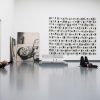Following up to a full day conferences on 8th December called “Dance and the Museum: Stretching the Boundaries” hosted by Het Firmament in Mechelen, Belgium.
I am reminded of the need for live inter-action, discussion and doing together in getting thoughts, ideas, provocations and critical thinking going. Too often, freelance dance artists – such as myself – work in isolation and it is essential (for me) to immerse myself, when I can, in groups of both like-minded and diverse thinking people.
As the practice of dance, and other art forms, adapt, shift and change in quickly shifting times I find ground in shared spaces of creative circles. Within those circulations I find, too, a need for negotiation within a healthy tension of expertise and need. Of motivations and agendas. Of wants and desires.
Isabelle Maidment, Asst Curator at TATE, spoke of programming and acquiring performance in the museum. She talked of “minor histories interwoven”. Those histories, though, (of performance/live art and dance) are different histories with different politics of the body and practice. I asked about the potential (curated) history that will reside for dance in the museum that will be both fragmented and with gaps. She responded saying that TATE is, first and foremost, a Visual Art Museum. Their interest is in programming and acquiring dance as “it moves into visual art practices”. I thought, Ok, then:
If TATE is programming and acquiring dance dance as “it moves (subsumed?) into visual art practices” and naming/curating those histories then dance needs to look at how it is being brought in and to ask how does visual art practice move into dance?
Aurelie Mouton-Rezzouk from Universite Sorbonne Nouvelle-Paris, presented case-studies on “sharing, cooperation, participation”. I was somewhat surprised by continuous use of the word “participation” across the day. Since Claire Bishop’s Artificial Hells I am more interested in what a post-participation moment might be. And how might we move past the binary between the doing and the participating to ways of being together.
The most promising part of the day for me was listening to Femke Gijselinck, Assistant to Anna Theresa deKeersmaeker/ROSAS and Caroline Dumalin from WIELS talk about re-mounting Work/Travail/Arbeid for the gallery. The commitment to working on dance’s terms that deKeersmaeker insists on is inspiring and produces work that is rigorous, crafted and honours the needs of dance from spatial, temporal and economic means in the visual art spaces she works in.
The most troubling part of the event was listening to Rein Wolfs from the Bundenskunsthalle in Bonn show images of the “Exhibiting a choreographer’s legacy: Pina Bausch and the Tanstheater” exhibition. What was most disturbing was his insistence that dance “brings life into the museum”, yet every images was of static objects (photographs, costumes, notes) from Bausch’s practice. Oddly enough there was not a trace of a human being (not even one visitor or guard standing) in any of the images. It felt as if Wolfs was more interested in displaying to us the architectural spaces of his museum then the life of Bausch’s work. I am still uncertain as to what I feel in regard to the replica of the Tanztheater rehearsal space (a former filmhouse) that was installed in the museum. It felt like a mausoleum rather than a dance studio. More death than life yet I appreciate that he engaged some of the dancers from the company in creating the installation, namely the studio replica. I also like the programming, films, talks and dance workshops that took place in the fake studio. Yet, I still felt that the life and vibrancy of Bausch cannot be communicated through ephemera.
Leaving the event I began to wonder where were the voices of the dancer? Of the dance historian? Why are most conversations about dance in the museum void of these important voices? It seems we, as a dance field, are putting our legacy and our future into the hands of curators who, while intentions are admirable, expertise and sensitivities are lacking.
I also mused on dance as a tool or mediation device in the museum vs a “staged” performance of dance. What are the differences? And how might craftsmanship be employed when dance is no longer about choreography but about inserting certain skill sets or ways of knowing into a space?
I also dream of platforms for dance discourse that is critical and reflective and addresses the dance archive (not leaving to hands of museum curators) and that is delivered by experts in the field of dance. They must be out there.
If, as the title of the conference suggests, we are “stretching the boundaries” of dance and the museum I end by asking, how and how far? How bold can the dancers and experts in the field be to ask questions, demand conditions for dance and move thinking forward towards better, more equal and ethical, collaborations.
And let’s not forget that the curators are not the only ones defining dance in the museums. What about the policies? The board of Trustees? What is really changing at deep policy level in museums to make sure dance is represented well and not as a footnote. Before an act of stretching the boundary must be clear. What are the boundaries? And how far are we willing to stretch them? We are a very flexible bunch. Let’s give it go!
…
Photo of Punt.Point at vanAbbe Museum
by Sara Wookey & Rennie Tang (2014)

Leave a Reply
You must be logged in to post a comment.